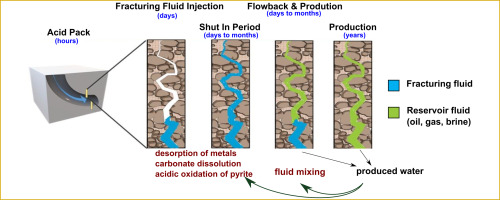当前位置:
X-MOL 学术
›
Sci. Total Environ.
›
论文详情
Our official English website, www.x-mol.net, welcomes your feedback! (Note: you will need to create a separate account there.)
Application of isotopic and geochemical signals in unconventional oil and gas reservoir produced waters toward characterizing in situ geochemical fluid-shale reactions.
Science of the Total Environment ( IF 9.8 ) Pub Date : 2020-01-23 , DOI: 10.1016/j.scitotenv.2020.136867 Thai T Phan 1 , J Alexandra Hakala 2 , Shikha Sharma 3
Science of the Total Environment ( IF 9.8 ) Pub Date : 2020-01-23 , DOI: 10.1016/j.scitotenv.2020.136867 Thai T Phan 1 , J Alexandra Hakala 2 , Shikha Sharma 3
Affiliation

|
Optimizing hydrocarbon production and waste management from unconventional oil and gas extraction requires an understanding of the fluid-rock chemical interactions. These reactions can affect flow pathways within fractured shale and produced water chemistry. Knowledge of these chemical reactions also provides valuable information for planning wastewater treatment strategies. This study focused on characterizing reservoir reactions through analysis of produced water chemistry from the Marcellus Shale Energy and Environmental Laboratory field site in Morgantown, WV, USA. Analysis of fracturing fluids, time-series produced waters (PW) over 16 months of operation of two hydraulically fractured gas wells, and shale rocks from the same well for metal concentrations and multiple isotope signatures (δ2H and δ18O of water, δ7Li, δ11B, 87Sr/86Sr) showed that the chemical and isotopic composition of early (<10 days) PW samples record water-rock interactions during the fracturing period. Acidic dissolution of carbonate minerals was evidenced by the increase in TOC, B/Na, Sr/Na, Ca/Na, and the decrease in 87Sr/86Sr in PW returning in the first few days toward the 87Sr/86Sr signature of carbonate cement. The enrichment of 6Li in these early (e.g., day 1) PW samples is most likely a result of desorption of Li from clays and organic matter due to the injection of fracturing fluid. Redox-active trace elements appear to be controlled by oxidation-reduction reactions and potentially reactions involving wellbore steel. Overall, PW chemistry is primarily controlled by mixing between early PW with local in-situ formation water however certain geochemical reactions (e.g., carbonate cement dissolution and desorption of 6Li from clays and organic matter) can be inferred from PW composition monitored immediately over the first ten days of water return.
中文翻译:

同位素和地球化学信号在非常规油气藏采出水中的应用,以表征原位地球化学流体-页岩反应。
从非常规油气开采中优化烃类生产和废物管理需要了解流体-岩石化学相互作用。这些反应会影响裂缝性页岩内的流路和产水化学。这些化学反应的知识也为规划废水处理策略提供了有价值的信息。这项研究的重点是通过分析美国西弗吉尼亚州摩根敦的Marcellus页岩能源与环境实验室现场产生的水化学特性来表征储层反应。分析压裂液,两个水力压裂气井运行16个月后的时间序列采出水(PW),以及来自同一井的页岩岩石中的金属浓度和多种同位素特征(水的δ2H和δ18O,δ7Li,δ11B,87Sr / 86Sr)表明,早期(<10天)PW样品的化学和同位素组成记录了压裂期的水-岩相互作用。碳酸盐矿物的酸性溶解是通过TOC,B / Na,Sr / Na,Ca / Na的增加以及PW中的87Sr / 86Sr的减少而证明的,这些PW在开始的几天内朝着碳酸盐水泥的87Sr / 86Sr特征返回。在这些早期(例如第1天)的PW样品中6Li的富集很可能是由于注入压裂液导致Li从粘土和有机物质中解吸的结果。氧化还原活性痕量元素似乎受氧化还原反应以及涉及井筒钢的潜在反应的控制。总体而言,PW化学作用主要是通过将早期PW与本地原位地层水混合而控制的,但是某些地球化学反应(例如,
更新日期:2020-01-23
中文翻译:

同位素和地球化学信号在非常规油气藏采出水中的应用,以表征原位地球化学流体-页岩反应。
从非常规油气开采中优化烃类生产和废物管理需要了解流体-岩石化学相互作用。这些反应会影响裂缝性页岩内的流路和产水化学。这些化学反应的知识也为规划废水处理策略提供了有价值的信息。这项研究的重点是通过分析美国西弗吉尼亚州摩根敦的Marcellus页岩能源与环境实验室现场产生的水化学特性来表征储层反应。分析压裂液,两个水力压裂气井运行16个月后的时间序列采出水(PW),以及来自同一井的页岩岩石中的金属浓度和多种同位素特征(水的δ2H和δ18O,δ7Li,δ11B,87Sr / 86Sr)表明,早期(<10天)PW样品的化学和同位素组成记录了压裂期的水-岩相互作用。碳酸盐矿物的酸性溶解是通过TOC,B / Na,Sr / Na,Ca / Na的增加以及PW中的87Sr / 86Sr的减少而证明的,这些PW在开始的几天内朝着碳酸盐水泥的87Sr / 86Sr特征返回。在这些早期(例如第1天)的PW样品中6Li的富集很可能是由于注入压裂液导致Li从粘土和有机物质中解吸的结果。氧化还原活性痕量元素似乎受氧化还原反应以及涉及井筒钢的潜在反应的控制。总体而言,PW化学作用主要是通过将早期PW与本地原位地层水混合而控制的,但是某些地球化学反应(例如,


























 京公网安备 11010802027423号
京公网安备 11010802027423号